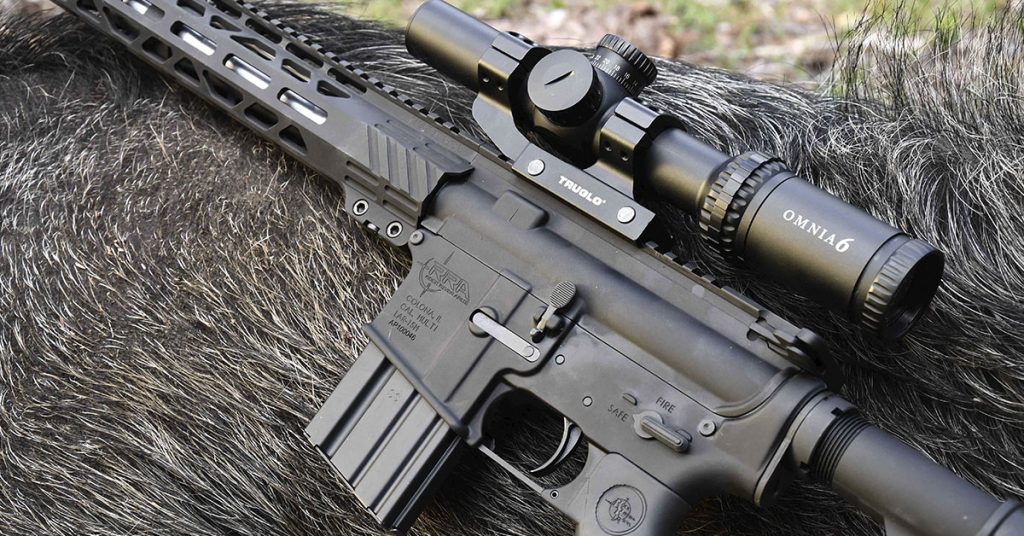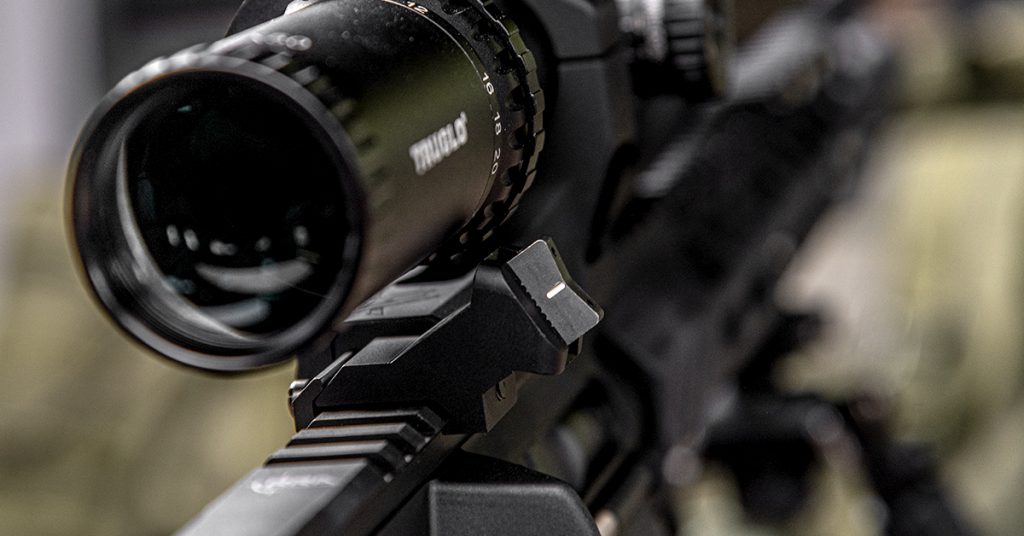In case you haven’t noticed, there seems to be a slight generational and cultural gap in the hunting world between those who have adopted the AR-15 platform for hunting and those who have not. That is not to say we have an either/or situation going on. None of us limit ourselves to one particular flavor of firearm. In fact, most of today’s avid sportsmen can count both ARs and the conventional bolt, lever, and pump rifles in their arsenals. But when it comes to hunting and ARs, the AR crowd certainly skews toward the more tender years compared to the seasoned hunters in our midst.
Of course, the explanation for this is perfectly sound and quite obvious; the younger crowd has grown up with the AR front and center. From video games to pop culture to the predominance of “tactical this” and “black gun that” across the shooting sports media, the AR platform understandably extends into the hunting realm for these enthusiasts. And if the AR provides an on-ramp for more people to become involved in hunting (especially the younger generations), then that is cause for celebration.

Given the state of our world today, with safety concerns elevated, supply chain disruptions causing difficulties in obtaining our shooting and hunting supplies, and the general uncertainty of what our personal and collective futures hold, prudent sportsmen who have yet to embrace the AR for applications beyond personal defense or plinking are now giving it serious consideration. In short, many of the holdouts are ready to jump onto the ARs-for-hunting train.
If that sounds like you and you haven’t really been paying attention to the goings on in the AR segment and aren’t sure how to approach ARs for hunting, we’re here to help you on your journey.
What Chamber?
For many years after the AR-15 moved to commercial availability (right after the sunsetting of the egregious Public Safety and Recreational Firearms Use Protection Act in 2004), you could purchase ARs in whatever caliber you liked, so long as it was 5.56 NATO/.223 Remington, for the most part. The 5.56/.223 is a proven caliber for defense and a wicked varmint buster, but as a round suited for large game animals…not so much.
Gradually, AR platform manufacturers like Rock River Arms and others began to develop AR barrels, receivers, and bolt carrier groups suited for calibers with genuine hunting credentials, most notably the .308 WIN.

Today, you can get an AR chambered for the most popular rifle cartridges going, such as the .204 Ruger, .350 Legend, .450 Bushmaster, 6.8mm, .300 AAC Blackout, .458 SOCOM, .308 WIN, 7.62mm, .224 Valkyrie, .243 WIN, 6mm ARC, 6.5 Creedmoor, 6.5 Grendel, .223 Wylde, .338 Lapua, and even .22 LR. The .308 WIN and 5.56/.223, though, still maintain dominance. It all comes down to the type of hunting you intend to pursue.
One round that has piqued a lot of interest for AR fans in the last couple years is the .350 Legend. Like the .450 Bushmaster, the .350 Legend is a straight-wall cartridge that packs a massive wallop on hogs and whitetail deer within typical whitetail hunting distances. This interest has come not so much from the .350 Legend’s terminal performance but that its dimensions allow its use in several states that have traditionally permitted only shotguns or handguns for deer hunting, not bottlenecked, “high-power” cartridges.
Hunters who pursue open-country critters like antelope and mule deer have also grown fond of the AR platform when chambered for proven long-reach rounds such as the .308 WIN and 6.5 Creedmoor. Part of the reason for this is that not only do these cartridges have the grit to put down large game efficiently and ethically at distance, the accuracy potential of many AR rifles match or exceed the capabilities of most shooters when taking long pokes. Rock River Arms, for example, promises one-inch MOA capability with its .308 WIN and 6.5 Creedmoor rifles, and our experience with RRA rifles have proven this to be true.
Sighting Systems
Aside from their respectable accuracy, most of today’s ARs that are suitable for hunting sport flat tops and full-length Picatinny rails from the back of the upper receiver to the end of their typically free-float handguard. This common configuration allows for practically any sort of optic system you desire—from a modest 3-9X scope to a high-magnification, BDC reticle unit suitable for mile-shots and that likely will cost more than the rifle on which it is mounted.
As with a bolt rifle setup, choosing an optic for a hunting AR boils down to your intended use and budget. Woodland- or swamp-cruising whitetail hunters can do well with a 2 or 3 MOA red dot or a low-power variable optic (LPVO). The advantage of these sight systems is that they are also suitable for close-quarter defensive work—meaning your hunting AR can serve double-duty as a home defender.
If long-range varmint or western big game hunting is your thing, then a conventional magnified optic with a BDC reticle is probably on the menu. Pretty much anything you would use on a bolt rifle is fair game for an AR. You can even go night or thermal vision if you choose to do so.

One thing we must mention, though, regarding optic setup with an AR is the scope mount.
With any scoped rifle, the goal is to mount the scope as close as possible to the barrel bore line to mitigate the effects of rifle cant (a result of the scope not being mounted perfectly square to the bore line…something that can be minimized or eliminated by using the Real Avid Level Right Pro). Scope mounting height can also affect your cheek weld and, thus, eye alignment. ARs, by virtue of the upper receiver design, tend to place optics higher above the bore line than that of a conventional bolt rifle. So, just be sure to use a mount system that keeps your scope as low to the bore line as possible while still providing for a comfortable cheek weld and good eye position behind the glass.
Something we recommend with an optic-mounted AR is to run backup open sights. For ARs with small-footprint reflex red dots, flip-up sights that are visible through the lens are an easy answer. These sights are mounted fore and aft of the optic on the Picatinny rail and can be flipped up when needed.
This type of open sight, though, does not work with magnified rifle scopes. For that, you need offset-angle backup sights. These sights mount to the Picatinny rail but are offset by about 45 degrees so that they clearance the scope’s ocular and objective bells and provide a clear view for establishing a sight picture. The catch is that the rifle must be rotated to achieve that sight picture. Yeah, it takes some getting used to, but it also means that you can use your scope-equipped hunting AR as a close-quarter defensive rifle if need be. We’ve used the XT12 offset BUIS system from XS Sights for this purpose and like it.

Upgrade Triggers
Just because the AR was developed as a defensive rifle platform does not mean that conventional firearm theories and best practices are moot. The fundamentals are the same across all types of firearms, and that includes trigger performance.
MILSPEC AR triggers, which is what you’ll find on most off-the-shelf ARs, are notoriously long, creepy, crunky, and simply have no place, in our opinion, on a rifle intended for precision shooting. All that to say, either purchase your AR with a quality two-stage trigger or step up to a precision drop-in trigger system such as those offered by Timney Triggers.
Installing aftermarket triggers in an AR is a simple process, and is even easier when installing drop-in triggers, as there are only two pins to remove and reinstall. Plus, the included directions are easy to follow and you can complete the job in minutes.
The advantage of a quality trigger is, of course, a serious reduction in shot disturbance that translates directly to improved downrange accuracy—just as it is with your precision bolt rifle. Make the investment and you’ll be glad you did.

AR Furniture
One of the many advantages of the AR platform is its inherent modularity. Modifying an AR requires minimal tools that most folks have on hand. If not, specialists like Real Avid have everything necessary to work on, modify, or build an AR.
The three furniture pieces of an AR include the buttstock, grip, and handguard. Typically, the handguard will be part of a coordinated package chosen by the manufacturer, meaning that you will likely buy your hunting AR based on the factory configuration and probably won’t want to change out the handguard. What you may want to modify is the buttstock and grip.

There are oodles of variations on these two parts across the aftermarket. We favor adjustable-length buttstocks because they allow us to maintain a desired length of pull and optic eye relief as clothing requirements shift from warm weather duds to bulky cold-weather gear. What you may want to consider is a stock such as RRA’s Marksman. This stock is not only 6-position adjustable, the cheek piece and butt plate are also adjustable, providing a true custom fit.
As for pistol grips, it comes down to what’s most comfortable for you. Many shooters are fine with the standard A2-style grip (pictured above and below). Others favor something a bit more ergonomic like a Hogue rubber overmold grip. For most hunting applications, the Hogue grip earns our favor. The finger grooves provide a positive grip and the rubber overmold prevents slippage when wearing gloves. It’s also more comfortable than the A2 grip.
As you can see, the AR has come a long way since the early days when the A2-style rifles dominated the civilian marketplace and chamber sizes were limited to the 5.56/.223. Now, these highly adaptable firearms have merged into the hunting lane with options galore and seemingly endless opportunities for DIY customizing to meet any hunting mission. Oh…and the ability to transition your hunting rifle to a defensive weapon makes the AR option all the more pragmatic for the “who knows what’s going to happen” world we live in today.





